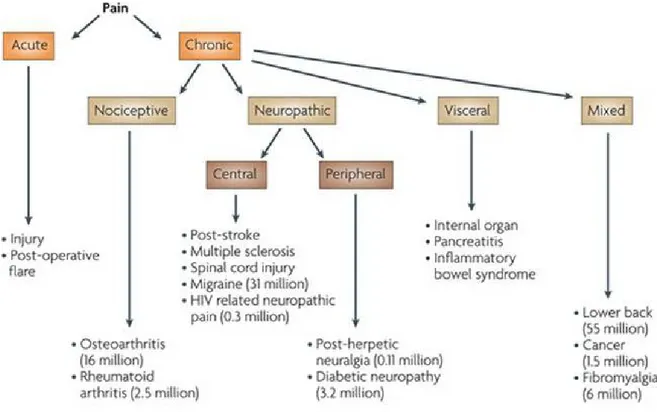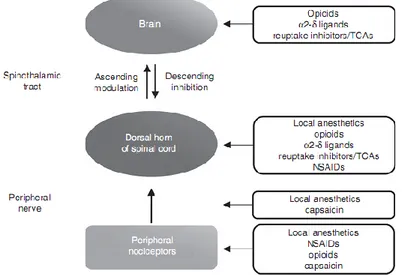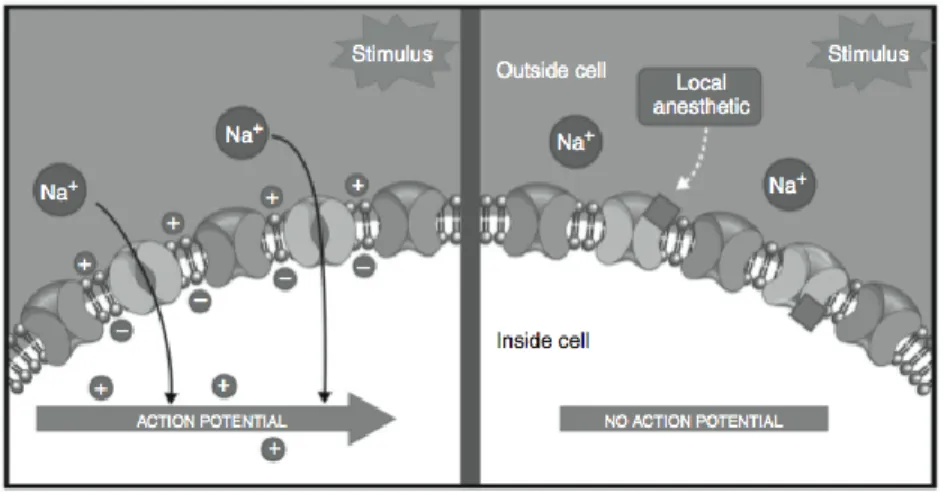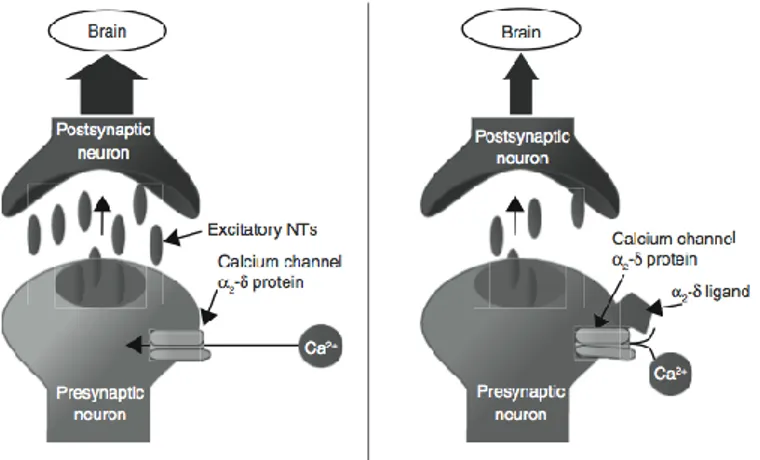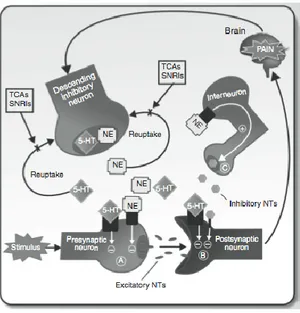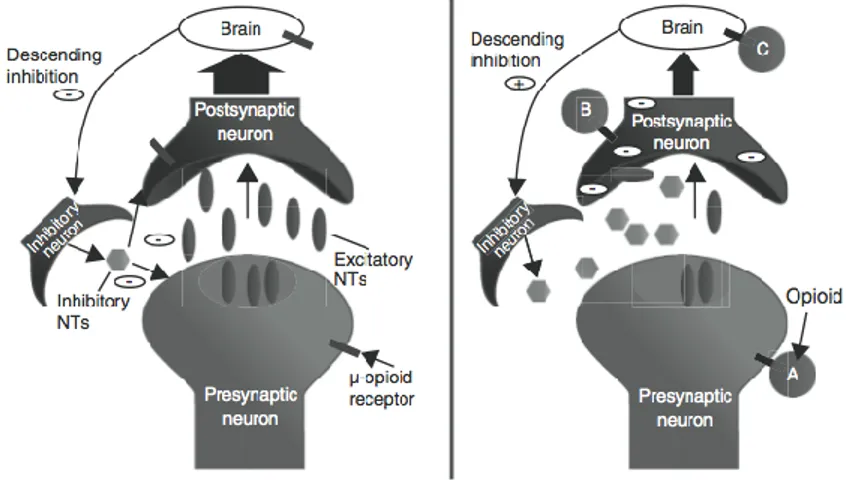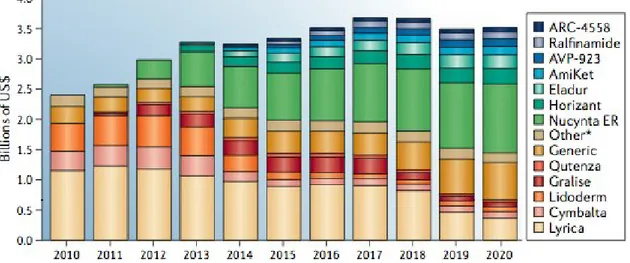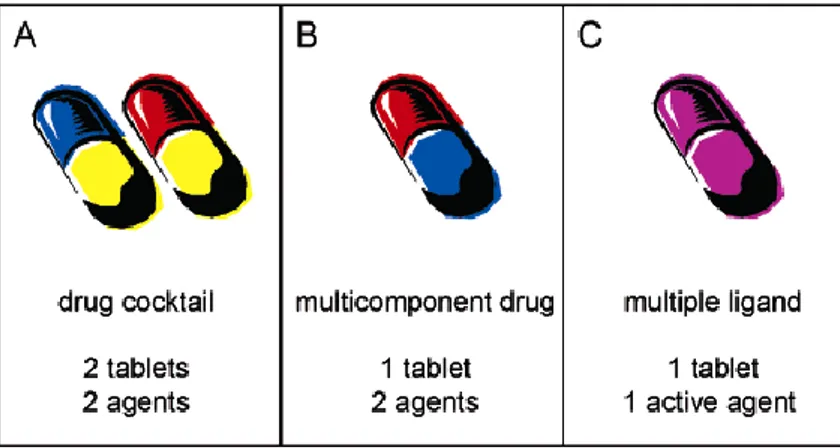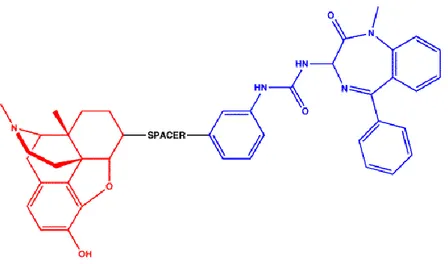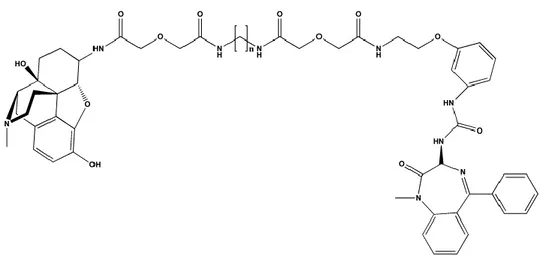UNIVERSITY OF CATANIA
DEPARTMENT OF DRUG SCIENCES
INTERNATIONAL DOCTORATE IN MEDICINAL CHEMISTRY
XXV CYCLE
______________________________________________________________
Rita Turnaturi
NEW PLAYERS IN AN OLD GAME:
Pharmacological Evaluation of the
Benzomorphan-Based Compound LP1
Design and Synthesis of Conformationally
Constrained Compounds as New
Tramadol-like Candidates
PhD THESIS
TUTOR: Prof. L. Pasquinucci
COORDINATOR: Prof. G. Ronsisvalle
______________________________________________________________
ABSTRACT ... 6 Chapter 1: INTRODUCTION ... 9 Pain ... 10 Pain pathways ... 13 Ascending pathway ... 13 Descending pathway ... 15 Pain Management ... 17
Different pharmacological interventions through distinct analgesic mechanisms of action... 17
Multidrug analgesic approaches multiple mechanisms of pain signaling and modulation. ... 28
Chapter 2: MULTITARGET LIGANDS ... 33
From multidrug combination therapy to the multitarget approach. ... 34
Multitarget analgesic ligands ... 36
Opioid-opioid multitarget ligands ... 38
Opioid/non-opioid multitarget ligands ... 49
Chapter 3: THE BENZOMORPHAN LIGAND LP1 ... 54
Pharmacological evaluation of the benzomorphan-based compound LP1 55 Background ... 55
Aim ... 57
Experimental Procedure ... 58
Cell Culture and Membrane Preparation ... 65
[35S]GTPγS Binding Studies ... 65
Results and Discussion ... 66
Conclusion ... 77
Chapter 4: DESIGN AND SYNTHESIS OF CONFORMATIONALLY CONSTRAINED COMPOUNDS AS NEW TRAMADOL-LIKE CANDIDATES ... 78
Design and synthesis of conformationally constrained compounds as new tramadol-like candidates ... 79
Background ... 79
Tramadol: clinical relevance... 80
Pharmacokinetic properties ... 85
Adverse effects ... 86
Tramadol: the importance of the mechanism of action ... 87
Other mechanisms of action ... 92
Drug design process ... 93
SAR studies ... 94
Design ... 100
Experimental Procedure ... 103
Chemistry ... 107
Synthesis of ethyl-2-(3-oxyciclohexyl)ethanoate ... 107
* Synthesis of isopropyl magnesium chloride ... 108
Synthesis of ethyl 2-(1,4-dioxaspiro[4,5]decan-7-yl)ethanoate ... 111
Synthesis of ethyl 2-(1,4-dioxaspiro[4,4]nonan-7-yl)ethanoate ... 112
Synthesis of 2-(1,4-dioxaspiro[4,5]decan-7-yl)-N-methylethanamide... 112 Synthesis of 2-(1,4-dioxaspiro[4,5]decan-7-yl)-N-ethylethanamide ... 114 Synthesis of 2-(1,4-dioxaspiro[4,4]nonan-7-yl)-N-methylethanamide .... 115 Synthesis of 2-(1,4-dioxaspiro[4,4]nonan-7-yl)-N-ethylethanamide ... 116 Synthesis of 2-(1,4-dioxaspiro[4,5]decan-7-yl)-N-methylethanamine ... 116 Synthesis of 2-(1,4-dioxaspiro[4,5]decan-7-yl)-N-ethylethanamine... 118 Synthesis of 2-(1,4-dioxaspiro[4,4]nonan-7-yl-N-methylethanamine ... 118 Synthesis of 2-(1,4-dioxaspiro[4,4]nonan-7-yl)-N-ethylethanamine ... 119 Synthesis of (4R/S,8S/R)-2-methyloctahydroisoquilin-8(8aH)-one ... 120 Synthesis of (4R/S,8S/R)-2-ethyloctahydroisoquilin-8(8aH)-one ... 121 Synthesis of (4R/S,7S/R)-2-methylhexa-1H-cyclopental[c]pyridine-7(7aH)-one ... 122 Synthesis of (4R/S,7S/R)-2-ethylhexa-1H-cyclopental[c]pyridine-7(7aH)-one ... 122 Synthesis of (4R/S,8S/R)-8R/S-(3-methoxyphenyl)-2-methyldecahydroisoquinolin-8-ol ... 123 Synthesis of (4RS,8SR)-2-methyl-8R/S-phenyldecahydroisoquinolin-8-ol ... 124 Synthesis of (4R/S,8S/R)-2-ethyl-8R/7S-(3-methoxyphenyl)- decahydroisoquinolin-8-ol ... 125
ol ... 126 Synthesis of (4aR/S,7aS/R)-7R/S-(3-methoxyphenyl)-2-methyloctahydro-1H-cyclopenta[c]pyridin-7-ol ... 126 Synthesis of (4aR/S,7aS/R)-2-methyl-7R/S-phenyloctahydro-1H-cyclopenta[c]pyridin-7-ol ... 127 Synthesis of (4aR/S,7aS/R)-2-ethyl-7R/S-(3-methoxyphenyl)-octahydro-1H-cyclopenta[c]pyridin-7-ol ... 128 Synthesis of (4aR/S,7aS/R)-2-methyl-7R/S-phenyloctahydro-1H-cyclopenta[c]pyridin-7-ol ... 128 References... 130
For the clinical management of acute and chronic pain, a possible therapeutic approach is the use of associations between two or more drugs, which produce their biological effects on two or more different sites of action, in order to modulate directly or indirectly profile analgesic and adverse effects (Argoff 2011). Given the advantages of polypharmacology, in the drug discovery process has been established the strategy "one-molecule multiple targets" (Morphy and Rankovic, 2009). The multitarget ligands provided better analgesic activity and fewer side effects - already observed in the association of drugs – coupled with favourable pharmacokinetic and pharmacodynamic characteristics. It is known that endogenous opioid peptides are the key mediators in the modulation of the pain transmission in descending pathways. Similarly, monoamine neurotransmitters - according to the location and type of receptor involved - can positively or negatively modulate the transmission of pain sensation. Considering that the various mediators involved in the circuit of pain represent potential targets for different pharmacological interventions, multitarget ligands possessing opioid-opioid or non-opioid-opioid mechanisms of action are potential drug candidates for the management of various pain conditions.
Multitarget ligands, able to act simultaneously on multiple opioid receptors subtypes, showed low propensity to induce side effects. In particular, it was found an improved analgesic profile associated with a reduced tendency to induce tolerance in mixed MOR (mu-opioid
receptor)-was demonstrated that the benzomorphan-based compound LP1 (Pasquinucci et al. 2010) exhibited high and good affinities versus MOR and DOR, respectively, and an analgesic potency comparable to morphine completely NX-reversed. Given this background, the present thesis focused on the study of the functional profile of LP1 through [35S]GTPγS
binding assay and tail flick test using selective MOR, DOR and KOR antagonists. Moreover, to further delineate its pharmacological profile, NX-M was administered either s.c. or i.v. to investigate if the LP1 action is centrally- or peripherally-mediated and it was also measured the LP1 ability to induce tolerance in regimen of repeated administration. Finally, LP1’s behavioural effects – antihyperalgesia and antiallodynia – in animal models of persistent pain were studied. Collected data indicated LP1 as a central-acting MOR agonist-DOR antagonist (Parenti et al., 2012b) with low capability to induce tolerance (Pasquinucci et al., 2012). Moreover, antihyperalgesic and antiallodynic effects of LP1 in animal model of persistent pain suggested this multitarget compound as a possible useful tool for chronic pain treatment.
In the multitarget ligand context, another strategy widely investigated is the combination of the MOR agonism with the monoamines reuptake inhibition (Bannister et al. 2009). A compound corresponding to this pharmacological profile is Tramadol (Leppert 2009), which has been selected as lead compound. The chemistry program was engaged with the aim to obtain compounds that maintained the mechanism of action of the
pharmacophoric features and their critical distances have been highlighted to identify a model that represented the interaction with MOR of Tramadol and its derivatives. Then, it has been designed and synthesised a series of conformationally constrained compounds as new Tramadol-like candidates, in which two pharmacophoric elements of tramadol - the lateral chain and the basic nitrogen - are constrained in a cyclised structures represented by the trans-decahydroisoquinoline and octahydro-1H-cyclopenta[c]pyridine nuclei. *
* ABBREVIATIONS: MOR, -opioid receptor; DOR, -opioid receptor; KOR, -opioid receptor; LP1, 3-
(1RS,2RS)-2-[(dimethyl-amino)methyl]-1-(3-methoxyphenyl)-Chapter 1
Pain
Pain, as defined by the International Association for the Study of Pain (IASP), is an “unpleasant sensory and emotional experience associated with
actual or potential tissue damage” (IASP 1994; Fishbain et al. 2010).
Pain is characterised by perceptive and emotional components. The first component is the nociception by which the perception of a negative and detrimental stimulus for the organism is transmitted to the CNS. The
emotional component, entirely beholder, represents the psychic
perception of pain that can be more or less intense as function of the emotional state of the individual. Thus, the pain experience is the result of the affective and cognitive dimensions, strongly influenced by psychic structure and socio-cultural factors.
Pain is physiological when it is an alarm signal for a tissue injury representing a system of defence essential to avoid damage. Pain becomes pathological when it remains, losing the initial meaning and becoming a disease (Mannion and Woolf 2000).
Pain is also defined and classified on the basis of either its persistence over time and underlying physical and psychological causes. As reported by Mannion and Woolf (2000) a first distinction, based on the pain persistence over time, is made between acute physiological pain and chronic pathological pain. Acute pain is a protective mechanism triggered by a specific physical cause and resolves in a short time following causal resolution. In contrast, chronic pain is commonly defined as persistent
pain and lasts beyond the ordinary duration of time that an injury needs to heal.
Considering causal factors, pain is commonly designated as nociceptive, neuropathic, inflammatory, functional, somatoform, or existential (Fig. 1.1). While acute pain is mainly caused by nociceptive stimuli - thermal, mechanical or chemical – chronic pain can be produced via nociceptive, neuropathic, existential, or mixed stimuli.
Figure 1.1. Pain Classification.
Neuropathic pain, due to neuronal lesions or nervous system dysfunctions, can be the consequence of an ectopic neuronal firing, or the result of releasing peptides by injured nerve contributing to inflammatory response, or it can be caused by inhibition of pathways in the brain and
spinal cord involved in transmitting peripheral signals. Inflammatory pain refers to spontaneous pain and hypersensitivity due to tissue damage or inflammation. Sensory afferent nerves are sensitive to inflammation and its chemical mediators, including bradykinins, prostaglandins, and leukotrienes. The stimulation of afferent neurons by inflammatory mediators can cause peripheral and central sensitization and a change in neuronal function that may evolve in chronic pain. However, a clear distinction between chronic neuropathic pain and chronic inflammatory pain is no always possible. In fact, typical components of an inflammatory process may become part of the mechanisms regulating neuropathic pain, since inflammation can trigger nerve injury and in this way produce neuropathic pain. Similarly, nerve injuries can lead to an inflammatory reaction (neurogenic inflammation) that contributes to the inflammatory pain expression.
Functional pain (non-nociceptive or non-neuropathic) probably due to abnormal pain processing or functioning of the nervous system, resulting in allodynia - from a stimulus that does not normally provoke an algesic response - and hyperalgesia - which is an increased response to a stimulation that is normally painful.
Somatoform pain is characterised by a strong psychological component. In this condition, patients complain of pain in one or more areas without the presence of a detectable medical cause. This form of pain is often accompanied by anxiety manifestations and often has effects on the patient's social life (Christo and Mazloomdoost, 2008; Omoigui 2007).
Pain pathways
Ascending pathway
Painful feelings originate from peripheral nociceptors (Omoigui 2007). In contrast to other types of sensory fibres, such as those for the sense of touch having at their endings specialized structures (such as Pacinian and Messner corpuscles), nociceptive fibres (the fibres carrying pain signals) possess free nerve endings. These free nerve endings form dense networks that are regarded as nociceptors. They are high threshold receptors, activated by stimuli of sufficient intensity to cause tissue damage.
Substance P, bradykinin, serotonin and histamine are endogenous substances typically realised in tissue lesions and capable to stimulate the peripheral nociceptors.
Nociceptors (Caterina et al. 2005) are distinguished in mechanical, activated by very intense stimulation (as sharp objects), thermal nociceptors, activated by temperatures above 45 °C, and polymodal nociceptors, activated by all types of stimuli. There are various types of nerve fibres (axons) whose free endings form nociceptors. These fibres connect all peripheral organs to the spinal cord and differ greatly both in diameter and in the thickness of the myelin sheath that surrounds them. Primary afferent fibres are classified according to three physiological criteria: 1) the speed of conduction, 2) the type of stimulus that evokes the response and 3) the temporal characteristics of the response to the stimulus. On the basis of these criteria, primary afferent fibres are distinguished in C and Aδ fibres. C fibres, unmyelinated and to slow speed of conduction, respond to mechanical and thermal stimuli. Aδ fibres
are myelinated and to faster conduction. There are three distinct types of Aδ fibres. Type I and type II Aδ fibres typically respond to heat, mechanical and chemical stimuli. Another type of Aδ, unresponsiveness to thermal stimuli, has been named high-threshold mechanoreceptors of large calibre, myelinated and to rapid conduction.
Painful stimuli cause the opening of ion channels and then flux of ions across cell membranes within the peripheral nociceptive afferent (Woolf 2004). Sufficiently strong stimuli generate depolarization and potential of action that are conducted via peripheral afferents to the dorsal horn of the spinal cord (Bingham et al. 2009).
After transmission to the second order neuron, the pain stimulus is transmitted to various supra-spinal structures via afferent fibres.
The cellular bodies of the afferent fibres are located in the spinal dorsal root ganglia. They enter the spinal cord through the dorsal roots and terminate in the grey matter of the posterior horns. C fibres project in the superficial layers of laminae I and II, whereas the Aδ fibres innervate the cell bodies of the lamina V. From cellular body of neurons in the laminae I and V originate the ascendant fibres projecting in the thalamus constituting the ipsilateral and contralateral spino-thalamic beams, which innervate the somato-sensory cortex. The somato-sensorial information is transmitted to the cerebral cortex through two ascendant systems, a lateral and a medial systems. The spino-thalamic tract is part of the lateral system and project to the thalamus. It elaborates the sensory and discriminative aspects of pain information. The spino-reticular-thalamic tract is part of the medial system and project to the reticular formation of
the brainstem and to the thalamus. Thalamus is a symmetric part of the brain and constitutes the main part of the diencephalon. The thalamus acts as a relay station, which disseminate the signals to various areas of the brain, including the cerebral cortex.
Cerebral cortex is the part of the brain where the perception as pain takes place. The perception of pain is due to the nociceptive transmission from the thalamus to the sensory cortex by the thalamus-cortical neuronal fibres. The processing of pain perception also involves structures pre-frontal, frontal and limbic (amygdala and hippocampus). Limbic system is a regulation centre of the pain threshold and of emotional reactions, thus the perception conscious arising from peripheral sensory input overlap the cognitive and affective components.
Cells of laminae II and III of the dorsal horn (SG) are inhibitory interneurons that innervate the laminae I and V. Interneurons are rich of opioid peptides and opioid receptors that activated by inhibitory descending pathway regulate the transmission between the primary afferent fibres and spino-thalamic tract neurons.
Descending pathway
Descending pathway modulates pain sensory. An important area for the descending pain modulation is the PAG. The PAG, an area rich of opioid peptides, receives inputs from different brain areas such as hypothalamus, cortex and thalamus. From PAG originate fibres that innervate an area of the brainstem called the RMN rich in serotonergic neurons. Hence, the fibres run in the dorsolateral funiculus of the spinal cord and terminate forming synapses with interneurons of the SG that
inhibit the spino-thalamic tract. Serotonin is the main neurotransmitter of this path. Another important area of the descending pathway is the locus
coeruleus by which originate noradrenergic fibres innervating the dorsal
horn. Processes mediated by monoaminergic neurotransmitters such as norepinephrine, serotonin and dopamine modulate pain signalling within the dorsal horn, although some of these neurotransmitters can exert either antinociceptive or pronociceptive effects, depending upon the subtype and location of the receptors involved (Benarroch 2008).
Descending serotonergic pathways can inhibit nociceptive signalling via 5-HT1 receptor activation. Specifically, activation of 5-HT1A receptors inhibits
the excitability of spinothalamic projecting neurons and excitatory (i.e., pain facilitatory) interneurons (Bannister et al. 2005). Similarly, 5-HT1B/D
receptor activation produce antinociception through inhibition of neurotransmitter release from primary nociceptive afferents (Benarroch 2008). In contrast, descending serotonergic pathway activation can promote nociceptive transmission by activating 5-HT2/3 receptors.
Dopaminergic pathways can either inhibit or facilitate nociceptive signalling. Descending dopaminergic pathways inhibit nociceptive signalling by activating D2 and D3 receptors on primary nociceptive
afferents and neurons in the dorsal horn, thus inhibiting pre-synaptic neurotransmitter release (Fleetwood-Walker et al. 1988; Benarroch 2008). However, dopamine can be pro-nociceptive if it activates D1 spino-thalamic
projecting (i.e., ascending) neurons (Coffeen et al. 2008). In contrast to serotonergic and dopaminergic receptor-mediated activity, each of which have pro- and antinociceptive effects, descending noradrenergic pathway
activation is only known to have antinociceptive effects (Benarroch 2008). Descending noradrenergic pathways, projecting to the spinal dorsal horn, originate from several areas within the pontine region of the brain (Hentall et al. 2003), and inhibit pain signalling by activating α2A receptors on
terminals of primary nociceptors, or by activating post-synaptic α1
receptors, causing release of inhibitory neurotransmitters GABA or glycine from inhibitory interneurons (Benarroch 2008).
Pain Management
Different pharmacological interventions through distinct analgesic mechanisms of action
Pain relief can be reached through the use of various analgesic drugs, each having distinct mechanisms and sites of antinociceptive activity. In fact, the multitude and complexity of neuronal mechanisms that contribute to the pain transmission and modulation provide several possible targets (Fig. 1.2) for pharmacological intervention (Argoff 2011).
Figure 1.2. Mechanisms involved in the endogenous painful stimuli inhibition and
Moreover, for specific kinds of pain states some classes of drugs may be more effective than others. Therefore, it is important a full understanding of the mechanisms by which each drug class produces analgesia in order to make an appropriate analgesic drug’s selection. For instance, lidocaine and bupivacaine are recommended for the neuropathic pain and the post-herpetic neuralgia (PHN) management. Lidocaine and bupivacaine, known as local anaesthetics, inhibit nociceptive signal conduction by blocking of neuronal membrane sodium channels at the site of application.
Lidocaine Bupivacaine
Local anaesthetics are also effective in the management of acute post-surgical pain (Fig. 1.3), although the most commonly used drugs for the treatment of acute and chronic musculoskeletal and post-surgical pain are the NSAIDs. The NSAIDs’ mechanism of action consists in the inhibition of the COX enzymes with a consequent reduction of inflammatory mediators such as the prostaglandins. For certain NSAIDs a further mechanism seems to be involved in the analgesic effect and consist in the block or inhibition of acid-sensitive ion channels within membranes of nociceptive neurons.
Figure 1.3. Local anaesthetics exert their antinociceptive effect by blocKing sodium (Na+) channels within neuronal membranes, thus inhibiting afferent neuronal excitability and
the propagation of nociceptive input via action potentials
NSAIDs as monotherapy showed suitable analgesia for mild to moderate pain, but in cases of severe pain they are used as adjunct remedy.
Acetaminophen share with NSAIDs the analgesic and antipyretic properties
but lack of anti-inflammatory activity due to its ability to inhibit the COX3
enzyme distributed to the SNC. In addition, acetaminophen has been suggested to act on the serotonergic inhibitory descending pathway and the endogenous opioid pathway.
Acetominophen Gabapentin
For severe pain management acetaminophen is used in multidrug therapies. For example, acetaminophen in combination with various
NSAIDs produces a satisfactory pain relief for the treatment of post
surgical pain with a side effects profile comparable to those of each single constituent in a monotherapy regimen. Some anticonvulsant drugs are
also effective analgesics and are often used in the management of neuropathic pain, diabetic neuropathy and PHN. The so-called α2-δ
ligands bind to the α2-δsubunit of voltage dependent calcium channels
within neuronal membranes inhibiting the release of excitatory neurotransmitter by pre-synaptic neurons (Fig. 1.4).
Figure 1.4. The α2-δ ligands are believed to promote analgesia by binding to the α2-δ
subunit of voltage-dependent calcium channels on presynaptic neurons and inhibiting the release of excitatory neurotransmitters.
In addition, α2-δ ligands increase the spinal norepinephrine concentration by the activation of the descending inhibitory pathways.
In patients with chronic neuropathic pain, α2-δ ligands induce a 50% reduction of the pain intensity and the principle side effects are dizziness, somnolence, peripheral oedema, headache and dry mouth. In this context, a new compound to enter the pain market is Gralise (extended release gabapentin; Depomed), a once-daily formulation of the anticonvulsant
gabapentin. In one recent study, gabapentin prevented acute pain after a
Figure 1.5. Monoamine re-uptake inhibitors such as tricyclic antidepressants (TCAs) and
serotonin and norepinephrine re-uptake inhibitors (SNRIs).
Neuropathic pain is also managed with monoamine re-uptake inhibitors that exert their analgesic effects increasing the activity of descending pain-suppressing pathways (Fig. 1.5).
TCAs (e.g., amitriptyline, clomipramine, desipramine, imipramine and
maprotiline), SNRIs (e.g., duloxetine and milnacipran) are also analgesic drugs belonging to the class of monoamine re-uptake inhibitors.
Clomipramine Imipramine Desipramine
Maprotiline Amitriptyline
Studies performed in patients with neuropathic pain the use of SSRIs (Hempenstall and Rice, 2002) (e.g., citalopram, fluoxetine and paroxetine) showed no benefit, contrarily to TCAs and SNRI that provided significant pain relief in chronic pain states. However, their efficacy monotherapy for nociceptive pain is less well established and limited by anticholinergic side effects, including dry mouth, constipation, blurred vision, confusion, fatigue and potential cardiac toxicity.
Duloxetine Milnacipram Citalopram
Fluoxetine Paroxetine
Opioids continue to be the mainstay of therapy against nociceptive pain
noxious thermal, chemical or mechanical stimuli. Opioids work at various sites of the pain pathway inherent to the modulation of pain (Ballantyne and Shin, 2008). The analgesic effects of opioids are prevalently mediated through the activation of MOR in the CNS that can inhibit afferent nociceptive impulse transmission as well as activate the descending inhibitory pathways or suppress descending facilitatory pain pathways (Fig. 1.6). A part of the opioid-mediated analgesia – especially in painful inflammatory conditions - can be recognised to their ability to bind peripheral MOR also responsible of nausea, vomiting, constipation and pruritus. The analgesic properties of opioids are due to simulating endogenous properties of pain perception. Endogenous opioids - such as endorphins, encephalin, and dynorphins - interact with opioid receptors located in the hypothalamus (involved in temperature regulation and hormonal secretion), in the forebrain (involved in behavioural patterns including anxiety and expression of emotions).
Figure 1.6. Opioids promote analgesia in a variety of ways, including: (A) decreasing
pre-synaptic release of excitatory neurotransmitters, (B) decreasing post-pre-synaptic neuronal excitability, and (C) promoting descending inhibition.
Opioids exhibit their analgesic effects by inhibition of calcium influx in the presynaptic membrane and substance P release and increasing potassium outflow. All these events determine hyperpolarization of presynaptic cells preventing nociceptive afferent information from spreading to adjacent neurons. Morphine is the prototype opioid agonist, which increases the threshold of pain perception. It binds strongly to the MOR, but also has agonistic effects at the KOR and DOR ( Golembiewski and Rakic, 2010). Common effects of morphine are sedation, nausea, a feeling of body warmth, pruritus, urinary retention, euphoria, and decreased ability to concentrate. Constipation is the only side effect lacking tolerance (Carinci and Mao, 2010). Morphine can be administered i.m., i.v., s.c., rectally, epidurally, i.t., or orally.
Morphine Hydromorphone Codeine
Hydromorphone hydrochloride, a hydrogenated ketone of morphine, is a
pure opioid agonist and its effects are similar to morphine. Hydromorphone may also cause dose-related respiratory depression, mood changes, mental clouding, euphoria, dysphoria, nausea, vomiting, and electroencephalographic changes. Like other opioids, hydromorphone long-term administration leads to constipation (Manchikanti et al. 2010).
analgesic, antitussive, and antidiarrheal properties and represents the prototype of the weak to mid-range opioid.
Fentanyl, a strong MOR agonist highly lipophilic, is administered both by
transdermal and buccal routes. For chronic pain management the
Fentanyl transdermal patch and the rapid-acting formulations, such as transmucosal and buccal tablets, are used.
Fentanyl Levorphanol Meperidine A potent synthetic opioid analgesic similar to morphine is Levorphanol
tartrate that in addition to its primary effect at the opioid receptor has
inhibitory effects both on NMDA receptors and serotonin and noradrenaline reuptake. Its NMDA actions seem to be valuable in neuropathic pain conditions where other analgesics fail.
Meperidine, known as pethidine is a rapid-acting synthetic opioid
analgesic drug with potent anti-spasmodic proprieties due to its structural similar to atropine. Meperidine acts primarily as a KOR agonist and, in addition to anticholinergic effects, has local anesthetic activity related to its interaction with sodium ion channels.
Meperidine is indicated for the treatment of moderate to severe pain, and is available as a hydrochloride salt in tablets, as syrup, or as im or iv injection.
Methadone Hydrocodone Oxycodone MOR interaction of Methadone produces morphine-like effects, and in addition it interact with voltage-gated potassium channels in the myocardium, which may lead to QT prolongation. Methadone is indicated for relief of severe pain and detoxification treatment. Moreover, preoperative treatment with a single dose of methadone, that has a long duration, improves post-operative pain in patients underwent complex spine surgery. Unlike morphine, methadone is a racemic mixture, one stereoisomer acts as a NMDA receptor antagonist that play an important role in the prevention of opioid tolerance, the other isomer is a MOR agonist.
Hydrocodone is structurally similar to codeine and produces effects most
similar to morphine. It acts primarily at the MOR, but it is also a weak DOR and KOR agonist, usually combined with a weaker analgesic such as acetaminophen, ibuprofen, or aspirin.
Oxycodone, with agonist activity versus MOR, DOR and KOR, is a potent
synthetic opioid structurally similar to codeine and hydrocodone. Oxycodone is used as a single agent or co-formulated with paracetamol, ibuprofen, and aspirin.
Oxymorphone provides excellent analgesia with a lower incidence of
Buprenorphine is a thebaine derivative initially approved as an alternative
to methadone for treatment of opioid addiction and moderate to severe chronic pain management. The mechanisms of action are incompletely understood but it results a partial MOR agonist and a weak KOR and DOR antagonist.
Buprenorphine Nalbuphine Oxymorphone
Nalbuphine hydrochloride is primarily a KOR agonist/MOR partial
antagonist analgesic, also able to bind DOR.
Opioid drugs’ class have significant differences in pharmacokinetics, pharmacodynamics, pharmacology, mechanisms of activity, and disease specific utility. However, opioids are considered second-line therapy for chronic pain conditions, such as neuropathic pain, diabetic peripheral neuropathy and PHN (PrzewlocKi and Przewlocka, 2001). Evidence for their utility in these conditions is inconsistent and controversial (Pergolizzi et al. 2008). In fact, chronic pain is persistent and could not resolve over time, thus the long-term use of opioid analgesics for management of this pain conditions can lead to the exacerbation of detrimental side effects (Bekhit 2010), including tolerance to analgesic effect (Benyamin et al. 2008). Tolerance implies the dose escalation dose of the drug to achieve
and maintain constant analgesic effect (Ueda and Ueda, 2009; Grecksch et al. 2006).
Multidrug analgesic approaches multiple mechanisms of pain signaling and modulation.
For the complexity of pain and the variety of physiological mechanisms involved a single analgesic agent may not provide optimal analgesia for certain types of pain. Thus, to enhance analgesia and/or reduce side effects the multidrug analgesic approaches or polypharmacology, otherwise the practice of combining different analgesic agents has been integrated into clinical practice for the treatment of both acute and chronic pain. As demonstrated in some clinical studies the multidrug therapy allow to reduce consummation of opioid analgesics and lowered the incidence of opioid-associated side effects (Christo and Mazloomdoost, 2008). Combining two or more analgesic drugs can produce either additive or synergistic effects. The analgesic effect resulting from the multidrug administration is said additive if the analgesia produced by the drugs combination is similar to that expected, evaluated considering the dose-response curves of each drug. Differently the analgesic effect resulting from a regimen of multidrug administration is said synergistic if the effect of the combination is greater than expected. The total dose of the synergistic combination can be lower than that of single analgesic agents, diminishing the risk of adverse effects associated with each drug. Different clinical trials performed on patients that underwent minor surgery revealed for the combination of NSAID with systemic opioids additive or synergistic analgesic effects, demonstrating the ability of additional NSAID
to reduce the dose of opioid with subsequent reduction of opioid-induced side effects. The co-administration of an NSAID, like indomethacin or ketorolac, to an opioid resulted to a better analgesia for the post-operative pain relief. As well as the combination of systemic NSAID with intrarticular bupivacaine reduced pain and analgesic requirements.
Ketoprofen Lidocaine Ropivacaine Similarly, the combination of ketoprofen with lidocaine reduced opioid analgesic requirements. Moreover, the intra-articular co-administration of ropivacaine, morphine and ketorolac lowered post-operative pain and morphine consumption. All these clinical trials seem to establish that peripheral-acting analgesics may be an important component of multimodal pain therapy. An improved analgesic efficacy in patients with moderate to severe neuropathic pain was reported for a multidrug regimen consisting of oxycodone and pregabalin. Experimentally, it was demonstrated that local anesthetics intrathecally administered potentiate spinal morphine antinociception.
The additive or synergistic analgesic effects produced by the co-administration of spinal bupivacaine and morphine is the consequence of conformational changes in spinal opioid receptors that lead to a decreased binding to MOR but increased binding to DOR and KOR.
Combination of α2-δ ligands, such as gabapentin or pregabalin, with nortriptyline or opioid analgesic, like morphine or oxycodone, provided better pain relief than the corresponding single-drug therapy in patients with PHN.
Moreover, recent experimental studies demonstrated additive effects between intrathecal morphine combined with α-adrenergic agonists such as norepinephrine, carbacol, or midazolam. In fact, in several chronic pain states the combination of monoamine-reuptake inhibitors with opioid analgesics seems to play a benefit role.
Other examples of effective combination drug therapies are the association of tramadol and acetaminophen, or tenoxicam and bromazepan, or fluoxetine and amitriptyline for pain associated with fibromyalgia, tizanidine and amitriptyline for chronic tension-type headache, and gabapentin and amitriptyline for chronic pelvic pain.
A valid analgesic effect results by the co-administration of two opioid drugs such as oxycodone and naloxone (Hermanns et al. 2012). In fact, a number of experimental data and clinical trials proved that the association of a MOR agonist/DOR-agonist – as well as a MOR-agonist/DOR-antagonist – improved the analgesia MOR-induced reducing the incidence of side effects by the reducing the requirement of MOR activation. In the clinical practice, the oxycodone/naloxone association reduces the development of the constipation maintaining a suitable analgesic effect.
Numerous guidelines for pain management supported the use of combination therapy in clinical practice. As demonstrated by a number of clinical studies, multidrug analgesia offer beneficial effects compared with single agent regimens.
To avoid the potential complications associated with polypharmacology, a single analgesic agent that act on multiple pain pathways through different mechanisms could represent a valid possibility for pain management.
For instance, the current standard treatment for neuropathic pain (Fig. 1.7) condition is the anticonvulsant pregabalin (Lyrica; Pfizer) that acts as agonist either of the GABA receptors and α 2δ subunit, and alters neuronal activity through modulation of the calcium channels. Despite this dual mechanism of action is valid in many neuropathic pain conditions, it is associated with several CNS-related side effects such as sedation and dizziness. For the treatment of PHN the anti-depressant
duloxetine (Cymbalta; Eli Lilly) is a multitarget agent that combines the
dual ability to inhibit the serotonin and noradrenaline reuptake.
Figure 1.7. The neuropathic pain market. Data are for the seven major markets (the
United States, Japan, France, Germany, Italy, Spain and the United Kingdom).
Another example of multitarget drug of newest enter in the pain market is
Nucynta ER (extended release tapentadol; Johnson & Johnson) possessing
a dual mode of action consisting of agonism of the MOR and inhibition of noradrenaline reuptake, and has demonstrated efficacy in both neuropathic and nociceptive pain conditions.
Nucynta is prescribed for conditions involving both acute and chronic pain, in fact its opioid-sparing effects and reduced potential for abuse could represent a clinical advantage in chronic pain conditions requiring long-term management. *
* ABBREVIATIONS: MOR, -opioid receptor; DOR, -opioid receptor; KOR, -opioid receptor; CNS, central nervous system; SG, gelatinous substance; PAG, periaqueductal grey; RMN, raphe magnus nucleus; GABA, -aminobutyric acid; PHN, post-herpetic neuralgia; NSAIDs, non-steroidal anti-inflammatories; COX, cyclooxygenase; TCAs, tricyclic antidepressants; SNRIs, serotonin and norepinephrine reuptake inhibitors; SSRIs, selective serotonin reuptake inhibitors; NMDA, N-methyl-D-aspartate; i.m., intramuscular;
Chapter 2
From multidrug combination therapy to the multitarget
approach.
For the treatment of some pain conditions drugs having biological activity at a single target could be insufficient. Recently the medicinal chemistry research focused on ligands possessing multiple activities, known as multitarget drugs. Compared with the multidrug combinations, the multitarget ligands could show several advantages, such as the more predictable pharmacokinetic and pharmacodynamic, improved patient compliance and a lower risk of drug–drug interactions (Berger and Whistler, 2010; Burgess and Williams, 2010).
In the past the medicinal chemistry research was aimed on the paradigm “one-target, one-disease”. However, nowadays is always more growing the idea to consider the design of agents that modulate multiple targets simultaneously, with the goal to enhance efficacy or improve safety respect to drugs addressed only a single target.
Several advantages, resulting from the clinical use of two or more drugs for the pain conditions management (Fig. 2.1 panel A), led to multicomponent drugs whereby two or more agents were co-formulated in a single tablet to make dosing regimen simpler and to improve patient compliance (Fig. 2.1 panel B) (Morphy and Rankovic, 2005).
For multicomponent drugs and multidrug combination approach there are significant clinical disadvantages. Indeed, main risks are related to differences in the relative rates of metabolism that could produce highly
complex pharmacokinetic/pharmacodynamic relationships leading to unpredictable variability.
Figure 2.1.Clinical situations for multitarget therapy.
The multitarget ligand approach - consisting in the development a single chemical entity able to modulate multiple targets simultaneously (Fig. 2.1 panel C) - could represent a suitable alternative to the multicomponent drugs and multidrug combination approach. Risk of drug-drug interactions with multitarget ligands could be lower and their development, in terms of the risks and costs involved, is in principle no different from that of any other single entity.
Three medicinal chemistry strategies are possible to design multitarget drugs (Fig. 2.2).
One of those consists in the connection of two or more pharmacophores directly (fused) or via a linker (conjugate) and the resulting ligand is appropriately named multivalent ligand. In this case, to design multivalent ligands should be considered the existing SAR of the components, with particular attention to the attachment sites of the pharmacophores to be connected.
On the basis of the design and synthesis of multivalent ligands, containing two or more distinct pharmacophores linked via a spacer, there is the expectation that they might be able to interact simultaneously with two receptor binding sites such as, for example, in a receptor heterodimer. However, when incorporated into the multivalent construct, the pharmacological characteristics (e.g. the receptor binding affinity and/or efficacy) of each pharmacophores may be altered. For instance, Portoghese et al. (1986) reported a range of bivalent opioid compounds with varying linker length designed with the aim to investigate pharmacodynamic and organizational features of opioid receptors.
Others medicinal chemistry strategies to design multitarget compounds are the so-called overlapping pharmacophores and the highly integrated pharmacophores approach (merged). Multitarget ligands based on highly integrated pharmacophores have been discovered by chance or from screening of compound libraries.
Multitarget analgesic ligands
As previously reported, the combination of two or more drugs producing their biological effects by interacting with two or more targets (multidrug
therapy) is a suitable and possible strategy widely used for the acute and chronic pain clinical management (Argoff 2011). From the numerous advantages providing by multidrug therapy, in the drug discovery process was established the “one molecule-multiple targets” approach. Besides an improved analgesic profile coupled to a less incidence of side effects, multitarget ligands possess favourable pharmacokinetic and pharmacodynamic proprieties.
Pain sensation involves multiple signalling and modulatory pathways, employing a variety of neurotransmitters and other mediators (Argoff 2011). For instance, in the descending pain pathways endogenous opioids are key mediators. As well as, the NE, 5HT and DA - depending on receptor type and location - can positively or negatively modulate pain signalling. Thus, single analgesic therapies may be limited in their ability to comprehensively target these mechanisms. Considering that all mediators involved in pain signalling could represent potential targets for pharmacological interventions, multitarget ligands with a mechanism of action opioid-opioid and opioid-non opioid could be potential drug candidates for the management of different pain states.
This change from “one molecule-one target” to “one molecule-multiple
targets” has several advantages compared to two drugs that are
administered separately (Morphy and Rankovic, 2005). This trend in the drug discovery process has already been reflected in a number of analgesic ligands that modulate different protein targets at the same time.
Opioid-opioid multitarget ligands
Most of clinical opioid analgesics, such as morphine, act via of MOR whose activation determine besides the analgesic effect also side effects - inhibition of gastrointestinal motility, respiratory depression, tolerance and physical dependence, often limiting their use in long-term treatment (Eguchi 2004; Bodnar 2010). Moreover, despite the potent analgesic profile, the use of KOR agonists is limited by their attitude to induce sedative, dysphoric and psychotomimetic effects. DOR agonists produce less physical dependence, respiratory depression and constipation than morphine but result weak analgesics and some of them produced convulsions in animals. Thus, selective agonists for MOR, DOR and KOR have limitations because of their side effects and/or weak analgesic activity.
Several evidences indicated that a multitarget opioid ligand could have therapeutic potential as potent analgesics with reduced side effects. TIPP-NH2 (a) was the first compound having a MOR agonist/DOR antagonist
profile. It displayed a moderate MOR affinity (Ki = 78.8 nM) and a high
affinity for the DOR (Ki = 3.0 nM) (Schiller et al. 1992). In GPI assay,
TIPP-NH2 exhibited a moderate MOR agonist potency (IC50 = 1.70 μM) and a
high DOR antagonist activity in MVD assay (Ke = 18.0 nM) (Schiller 1999).
With the aim to improve the MOR affinity was synthesised the DIPP-NH2
(b) peptide that possessed a greater MOR affinity and potency for both MOR and DOR, maintaining the efficacy profile of the parent compound.
(a) TIPP-NH2
DIPP-NH2[Ψ ] (c) displayed a better ratio of MOR and DOR affinities (Ki =
0.94 and 0.44 nM, respectively) and in the GPI assay was more potent as a MOR agonist (IC50= 7.71 nM) but still retained a high DOR antagonist
activity (Ke = 0.53 nM) in the MVD assay. In the rat tail-flick test, given
i.c.v. DIPP-NH2[Ψ ] was more potent than morphine and produced a lower
analgesic tolerance and no physical dependence in regimen of chronic administration.
(b) DIPP-NH2 (c) DIPP-NH2[Ψ ]
Balboni et al. (2002) synthesised a series of multitarget Dmt-Tic analogs. All synthesized compounds (Fig. 2.3) showed a similar DOR binding affinity compared to the reference compound Dmt-Tic-OH (d) (Ki ≤ 0.13
Dmt-Tic-OH (d)
Derivative e.2 exhibited a DOR/MOR agonist activity, while compounds e.3 and e.4 exhibited potent DOR antagonist and MOR agonist activities.
(e)
Figure 2.3. Dmt-Tic analogs structures.
Endomorphin-1 and endomorphin-2 were investigated with the purpose to develop MOR/DOR ligands. The substitution of Tyr1 with Dmt in these
opioid peptides enhanced the binding affinities and functional potencies
versus MOR and DOR (Salvadori et al.1995; Bryant et al. 1998; Sasaki et al. 1999). For instance, the ligand H-Dmt-Pro-Phe-NH-C2H4-Ph showed
potent MOR agonist activity (GPI, IC50 = 5.03 nM) and a moderate DOR
antagonist activity (MVD, pA2 = 7.05).
The peptide H-Dmt-Tic-Gly-NH-Bzl named UFP-505, as tested by radioligand binding studies and functional assays, behaved as a potent MOR agonist and DOR antagonist (Balboni et al. 2002).
Endomorphin-1 and endomorphin-2 analogues containing either 3-(1-naphthyl)-D-alanine (D-1-Nal) or the 3-(2-3-(1-naphthyl)-D-alanine (D-2-Nal) residue at position 4 were synthesised (Fichna et al. 2007). A significant MOR agonist activity (GPI, IC50= 15.8 nM) and a moderate DOR antagonist
activity (MVD, Ke = 62.4 nM) were described for the peptide
H-Dmt-Pro-Trp-D-1-Nal-NH2. The replacement of the Phe residue in position 3 of
[Dmt1]EM2 with the Tmp led to a MOR agonist/DOR antagonist profile (Li
et al. 2007).
MOR/DOR ligands were also obtained through modification performed on encephalin peptide. For instance, the dimeric encephalin analogue Biphalin (Lipkowski et al. 1982), (H-Tyr-D-Ala-Gly-Phe-NH)2) bind MOR
and DOR receptors with high affinity (IC50= 1.4 and 2.6 nM, respectively)
and displayed MOR/DOR agonist activities (Horan et al. 1993). After systemic administration, Biphalin produced antinociceptive effect comparable to morphine, but induced no or lower dependence than morphine following chronic use (Lipkowski et al. 1996).
(f)
The piperazine biphalin derivative, H-Tyr-D-Ala-Gly-Phe-PPz<-Phe-Gly-D-Ala-Tyr-H, showed an excellent affinity versus MOR and DOR (IC50= 0.48
and 0.65 nM, respectively) and possessed MOR/DOR agonist activities (GPI, IC50= 2.5 nM; MVD, IC50= 9.3 nM) (Mollica et al. 2005). Cyclic
biphalin analogues were also synthesised and the most interesting peptide (f), exhibited better DOR/MOR affinities compared to biphalin (IC50= 0.87
and 0.60 nM, respectively) maintaining its efficacy profile (Mollica et al. 2006).
MMP-2200, a glycosylated encephalin analogue (g), produced dose-related antinociception blocked by the MOR-selective antagonist β-FNA and the DOR-selective antagonist NTI (Do Carmo et al. 2008). Compared with morphine, MMP-2200, at the antinociceptive dose, possessed a low propensity to induce locomotor stimulation, tolerance, and physical dependence in mice.
(g)
Moreover, encephalin-like tetrapeptides with a N-phenyl-N-piperidin-4-yl-propionamide moiety at the C-terminal resulted highly potent ligands of MOR and DOR (Lee et al. 2011). One of them (h) tested in an animal model of neuropathic pain, induced by the spinal nerve ligation, showed significant antiallodynic and antihyperalgesic effects.
(h)
Purington et al. (2012) developed a series of potent non-selective opioid tetrapeptides having different efficacy at MOR and DOR. In particular, KSK-103 (i) bound with equal affinity to MOR and DOR (Ki=2.4 ± 0.7 nM
and 2.3 ± 0.5 nM, respectively) and, as evaluated by [35S]GTPγ S binding
assay, it was a DOR antagonist and a MOR agonist with a greater potency than morphine (EC50=4.7±0.7 nM, Emax= 59±11).
(i)
Recently, novel dermorphin tetrapeptides conformational constrained were also synthesised (Vandormael et al. 2011) (l, m, n, o). Most of these peptidic ligands displayed binding affinities in the nanomolar range for both MOR and DOR. Moreover, by measurements of cAMP accumulation and phosphorylation of extracellular signal regulated kinase were established their MOR/DOR agonist properties.
(l) (m)
(n) (o)
The first non-peptidic MOR agonist/DOR antagonist ligand was the NTI derivative, 7'-phenoxynaltridole (p), possessing a powerful DOR antagonist
activity (Ke = 0.25 nM in the MVD test) and a weak MOR agonist activity
(IC50 = 450 nM in the GPI test) (Ananthan et al. 1998).
(p)
SAR studies on derivatives of NTX with a significant DOR selectivity (Takemori and Portoghese, 1992) allowed obtaining a series of pyrido- and pyrimidomorphinans (Ananthan et al. 1999). By this series SoRI 9409 (q), with mixed MOR and KOR agonist activities and DOR antagonist activity, showed a limited (or non-existent) antinociceptive tolerance induction capability.
(q)
Compounds SoRI 20411 and SoRI 20648 were synthesised with the aim to increase the antinociceptive efficacy of SoRI 9409. Those compounds showed MOR agonist/DOR antagonist activities in the MVD and GPI assays confirmed also in the [35S]GTPγ S binding assay (Ananthan et al.
2004). SoRI 20648 was less effective in In vivo tests, while SoRI 20411 displayed a full MOR agonist activity.
By a series of alkoxymorphinan-6-one derivatives emerged 14-ethoxymetopon ligand with a N-phenylethyl group (r) having higher MOR/DOR affinity and, in the hot-plate test, exhibited a greater antinociceptive potency than morphine (Lattanzi et al. 2005).
Modifications of oxymorphinindole, a selective DOR partial agonist, were made to obtain multitarget opioid analgesics (Grundt et al. 2003). The phenethylamine derivative (s) exhibited similar MOR (Ki= 1.68 nM) and
DOR affinities (Ki = 1.10 nM) and was a full MOR agonist and a DOR
partial agonist in the[35S]GTPγ S assay.
(r) (s)
From compound BW373U86 (t), (Portoghese et al. 1988; Dondio et al. 1998) a potent and selective DOR agonist, a series of benzhydryl piperazine compounds were designed and synthesised (Bishop et al. 2003). Moving the diethylamide function of BW373U86 to the meta-position provided a MOR/DOR agonist with higher MOR activity than that of BW373U86 and decreased DOR activity. Replacement of the
m-diethylamide with m-N-methylanilide (u) induced an increase in the MOR/DOR activities (EC50= 1.22 and 1.47 nM, respectively).
(t) (u)
Derivatives of mitragynine, a major indole alkaloid isolated from the Thai medicinal plant Mitragyna speciosa possessing opium-like properties, were also synthesised (Matsumoto et al. 2008). In this context, MGM-9 (v) exhibited high affinity for MOR and KOR (Ki= 7.3 and 18 nM, respectively)
and showed potent opioid agonistic proprieties versus MOR and KOR.
(v)
In mouse tail-flick s.c. and oral administration of MGM-9 produced potent antinociceptive effects and induced less hyperlocomotion and fewer rewarding effects than morphine. However, MGM-9 in regimen of repeated administration for five consecutive days induced antinociceptive tolerance.
N-naphthoyl-β -naltrexamine (z) selectively activated heteromeric MOR
and KOR in HEK-293 cells and induced potent antinociception in mice without provoke tolerance (Yekkirala et al. 2011).
(z)
By a series of morphinan derivatives emerged the compound MCL-145 (a2) showing in radioligand binding studies nanomolar affinity versus KOR and MOR (Ki= 0.078 and 0.20 nM, respectively) (Mathews et al. 2005).
(a2)
In the [35S]GTPγ S binding assay MCL-145 resulted a potent KOR/MOR
agonist (EC50= 4.3 nM Emax= 80% and EC50= 3.1 nM Emax= 42%,
respectively). Moreover, in the tail-flick test MCL-145 was equipotent to morphine.
ATPM (b2) compound acted as a full KOR agonist and a partial DOR agonist (Wang et al. 2009). Moreover, in comparison to (-)U50,488H, ATPM
demonstrated more potent antinociceptive effect and a less sedative effect. In relation to (-)U50,488H and morphine, ATPM in regimen of chronic administration showed less potential to develop antinociceptive tolerance.
(b2)
Opioid/non-opioid multitarget ligands
Based on the observation that an antagonistic effect on CCK2 receptors
blocks morphine tolerance, multitarget ligands possessing CCK2
antagonistic and opioid agonistic activities were designed and synthesized. For instance, starting by the peptide named SNF-9007 (Fig. 2.4), that is a potent and highly selective CCK2 agonist with a weak DOR agonist profile,
were synthesised analogues in order to move the profile of efficacy versus CCK2 antagonism (Slaninova et al. 1991).
Asp-
Tyr
1-D-Phe
2-Gly
3-Tr
p
4-NMeNle
5-Asp
6-Phe
7-NH
2Figure 2.4. Aminoacidic sequence of the SNF-9007 peptide. Pink aminoacids represent
the opioid pharmacophore, the blue ones the CCK2 pharmacophore.
[desAsp0]-SNF-9007 (Neumeyer et al. 2000) analogue possessed an
improved binding affinity at the DOR and MOR (Ki= 1 and 100 nM,
respectively) and high binding affinity for CCK2 receptors (Ki = 15 nM) and
micromolar affinity at the CCK1 receptors (Ki= 3,600 nM). In the functional
opioid receptors. Additional structural modifications led to the analogues Tyr1-D-Phe2-Gly3-D-Trp4-NMeNle5-Asp6-Phe7-NH2 and Tyr1-D-Ala2-Gly3
-D-Trp4-NMeNle5-Asp6-Phe7-NH2 displaying excellent affinities for the DOR
and CCK2 receptors; these compounds also had good MOR affinity.
MOR-CCK2 ligands were synthesised using non-petidic nuclei that are
oxymorphone for the MOR pharmacophore and L-365,260 for the CCK2
antagonist pharmacophore linked by different spacer length (Fig. 2.5) (Zheng et al. 2009; Portoghese et al. 1986).
Figure 2.5. MOR-CCK2 peptides. Red portion is the opioid pharmacophore (oxymorphone), the blue one is the CCK2 antagonist pharmacophore (L-365,260).
Binding assays, performed on CHO cells expressing CCK2 and MOR,
showed that ligands having spacer lengths of 16 (d2) or 18 atoms (f2) (Fig. 2.6) possessed higher CCK2-affinity in co-expressed cells (Ki= 57 and 33
nM) relative to cells that expressed only CCK2 receptors (Ki= 356 and 71
Figure 2.6. MOR-CCK2 peptides. n=0 (d2) and n=2 (f2).
Both peptides revealed high affinities for the MOR in CHO cells expressing either MOR or CCK2 receptors (Ki= 8.3 and 5.7 nM, respectively) and
co-expressing MOR and CCK2 receptors (Ki= 3.9 and 7.3 nM, respectively). In
vivo experiments showed that those ligands did not produce tolerance.
Several evidences proved that a ligand able to simultaneously activate MOR and antagonise Substance P function by blocking its NK1 receptor, was a valid approach to produce a significant analgesic effect with a low incidence to tolerance induction (King et al. 2005; Misterek et al. 1994). The chimeric peptide AA501 (Boyle et al. 1994), with an opioid receptor agonist pharmacophore biphalin-related and the NK1 antagonist pharmacophore derivative of tryptophan connected through a hydrazide bridge (Fig. 2.7), revealed a reasonable MOR affinity (Ki= 80 nM) and a
Figure 2.7. AA501 peptide. Red aminoacids represent the opioid pharmacophore, the
blue ones the NK1 pharmacophore.
The compound H-Tyr-D-Ala-Gly-Phe-Phe5-Pro-Leu-Trp-O-3,5-Bzl(CF3)2,
known as TY003, exhibited a nanomolar affinity versus DOR and MOR (Ki
= 15 and 28 nM, respectively) and a subnanomolar affinity for the NK1 receptors (Ki= 0.88 nM) (Yamamoto et al. 2007). The substitution of Phe5
with Gly5 in the TY003 peptide gave a compound with a lower DOR affinity
and preserved MOR and NK1 receptors affinities. Other analogues of TY003 with Leu5 and Met5, besides to show better DOR affinity (Ki= 5.0
and 2.8 nM, respectively), retained a high affinity for the NK1 receptors (Ki= 0.8 and 0.29 nM, respectively). The oxidation of Met5 led to an
increased affinity for the NK1 receptors (Ki= 0.2 nM). The replacement of
the Met5 with the bioisostere Nle5 increased the DOR affinity (Ki= 1.8 nM)
but the MOR and NK1 Ki values were increased. N-methylation at position
5 gave a compound that showed a significant decrease in binding affinity for the DOR (Ki= 77 nM) and MOR (Ki= 140 nM) while maintaining a high
affinity for the NK1 receptors (Ki= 0.71 nM).
SR14150 (g2) and SR16835 (h2) are moderately selective nociceptin/orphanin FQ (NOP) receptor agonists (Khroyan et al. 2011). In
the [35S]GTPγ S binding assay, SR14150 was a partial agonist at both
NOP and MOR, whereas SR16835 was a full agonist at the NOP receptor with low efficacy versus MOR.
(g2) (h2)
Using mice in chronic pain subsequent to spinal nerve ligation surgery, SR14150 and SR16835, administered s.c., had antiallodynic activity when mechanical allodynia was measure
d with von
Frey monofilaments.Analogously, Tramadol and its derivative Tapentadol (Wade and Spruill, 2009) combining weak MOR agonism and monoamine reuptake inhibition produced significant analgesic effect with low incidence of side effects MOR agonist induced. *
* MOR, -opioid receptor; DOR, -opioid receptor; KOR, -opioid receptor; SAR, structure-activity relationship; NE, norepinephrine; 5-HT, serotonin; DA, dopamine; GPI, guinea pig ileum; MVD, mouse vas deferens; i.c.v., intracerebroventricular; Tmp, 2’,4’,6’-trimethylphenylalanine; NTI, naltrindole; FNA, -funaltrexamine; NTX, naltrexone; s.c., subcutaneous; NK, neurokinin; CCK, cholecystokinin; NOP, nocicetin/orphanin FQ peptide.
Chapter 3
Pharmacological evaluation of the benzomorphan-based
compound LP1
Background
Despite MOR opioid analgesics are the standard treatment options for acute and chronic pain management, their long-term use induce the development of tolerance to the analgesic effect that could exacerbate other side effects (Brush 2012). The dissociation of analgesia from tolerance using MOR selective agonists is nearly impossible (Eguchi 2004; Bodnar 2010). Moreover, the design and synthesis of ligands highly selective for DOR and KOR as a strategy to overcome or limit MOR-mediated tolerance was unsuccessful. On the contrary, it has been demonstrated that ligands capable to target simultaneously different receptors could represent suitable candidates for the treatment of chronic pain (Dietis et al. 2009; Prezzavento et al. 2010; Schiller 2010). For instance, an improved antinociception and a low propensity to develop tolerance were reported for ligands possessing MOR-DOR agonist activity as well as MOR agonist-DOR antagonist activity.
Pasquinucci et al. (2010) described the synthesis and SAR of opioid ligands based on the 6,7-benzomorphan class. In particular, it was synthesised a new series of 5,9-dimethyl-2'-hydroxy-6,7-benzomorphan derivatives (12–22) by introducing different functional groups on the N-substituent such as an aromatic ring and/or alkyl residues linked by an N-propanamide or N-acetamide spacer (Fig. 3.1).
Figure 3.1. Structures of N-substituted 6,7-benzomorphan ligands 12–22.
Data obtained by competition binding assays confirmed the critical importance of the N-substituent that confers affinity and selectivity versus different opioid receptors subtypes. The most promising compound was 3- [(2R,6R,11R)-8-hydroxy-6,11-dimethyl-1,4,5,6-tetrahydro-2,6-methano-3-benzazocin-3(2H)-yl]-N-phenylpropanamide named LP1 (Fig. 3.2).
Figure 3.2. The benzomorphan-based compound LP1.
LP1 exhibited high and moderate affinity for MOR and DOR (KiMOR=0.83 ±
0.05 nM and KiDOR=29 ± 1 nM) (Table 3.1). In the tail flick test, the
antinociceptive potency of LP1 was comparable to that of morphine
O H C H3 CH3 N N O H
(ED50=2.03 mg/kg s.c. vs. 2.7 mg/kg s.c.) and it was completely
naloxone-reversed.
Ki (nM) ± SEMa,b
Comp. n R1 R2 MOR DOR KOR
12 (LP1) 2 H Ph 0.83 ± 0.05 29.1 ± 1 110 ± 6 13 2 H c-C6H11 56 ± 3 > 5,000 501 ± 25 14 2 Me Ph 65 ± 3 > 5,000 261 ± 14 15 2 Et Ph 136 ± 7 > 5,000 70 ± 4 16 2 H Bn 105 ± 6 > 5,000 237 ± 13 17 2 H CH2-c-C6H11 107 ± 6 > 5,000 134 ± 7 18 2 H tBu 372 ± 18 > 5,000 422 ± 20 19 1 H Ph 722 ± 40 > 5,000 > 5,000 20 1 H c-C6H11 2,930 ± 161 > 5,000 612 ± 27 21 1 Me Ph 1,370 ± 69 > 5,000 339 ± 17 22 1 Et Ph 1,120 ± 66 > 5,000 335 ± 17 DAMGO 0.87 ± 0.6 2,670 ± 112 > 5,000
a Values are means ± SEM of three separate experiments, each carried out in duplicate.
b Kivalues were obtained as [3H]DAMGO displacement for the MOR, [3H]DPDPE displacement for the DOR, and
[3H]U69,593 displacement for the KOR.
Table 3.1. Competition binding versus MOR, DOR and KOR of
5,9-dimethyl-2'-hydroxy-6,7-benzomorphan derivatives 12-22.
Aim
In light of the significant antinociceptive effect and interesting profile of affinities versus MOR and DOR of LP1, the purpose of this thesis was to study of the functional profile of LP1 through [35S]GTPγS binding assay.
To further assess the involvement of opioid receptors subtypes in LP1 effect, in the tail flick test were used selective antagonists for MOR, DOR and KOR, NLZ, NTI and norBNI, respectively (Bedini et al. 2010). To delineate the pharmacological profile of LP1, the effect of NX-M, a non-selective opioid receptor antagonist by i.c.v. or s.c. injection, was
investigated to determine whether the antinociception produced by LP1 was central or peripheral (Craft et al.1995). Moreover, it was assessed and compared the induction of tolerance to the antinociceptive effects of LP1 and morphine. Finally, LP1 was tested in a model of neuropathic pain - induced by CCI of the left sciatic nerve - and inflammatory pain - induced by i.pl. injection of carrageenan.
Experimental Procedure
Resolution of (-)-cis-(1R,5R,9R)-N-normetazocine
The starting material for the synthesis of the 6,7 benzomorphan-based compound LP1 was the (-)-cis-(1R,5R,9R)-N-normetazocine by the resolution of the optical isomer of the (±)-cis-N-normetazocine ((±)- (2R/2S,6R/6S,11R/11S)-6,11-dimethyl-1,2,3,4,5,6-exahydro-2,6-methan-3-benzazocin-8-olo) (Fig. 3.3).
Figure 3.3.(-)-cis-(1R,5R,9R)-N-normetazocine structure.
Brine et al. (1990) reported and improved resolution procedure (Scheme 3.1) in which (±)-cis-N-normetazocine (90 mmol) dissolved in chloroform (138,6 ml) and ethanol (109,2 ml) was added under nitrogen to a solution of (+)-tartaric acid (22,5 mmol) in water (54,6 ml). The biphasic mixture resulting was refluxed for 21 hours, then was kept to 45°C for 6 hours and finally to rt overnight. By filtration was collected the crystallised
